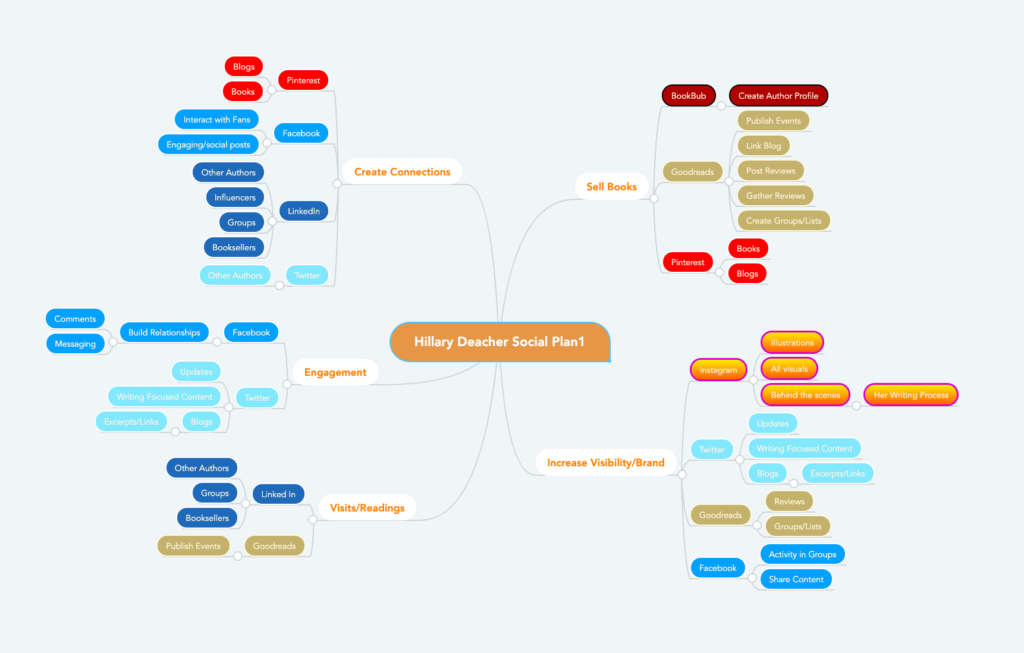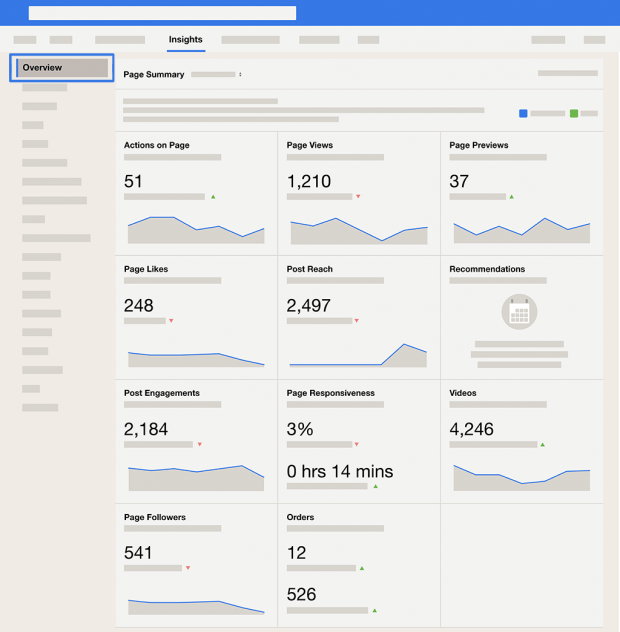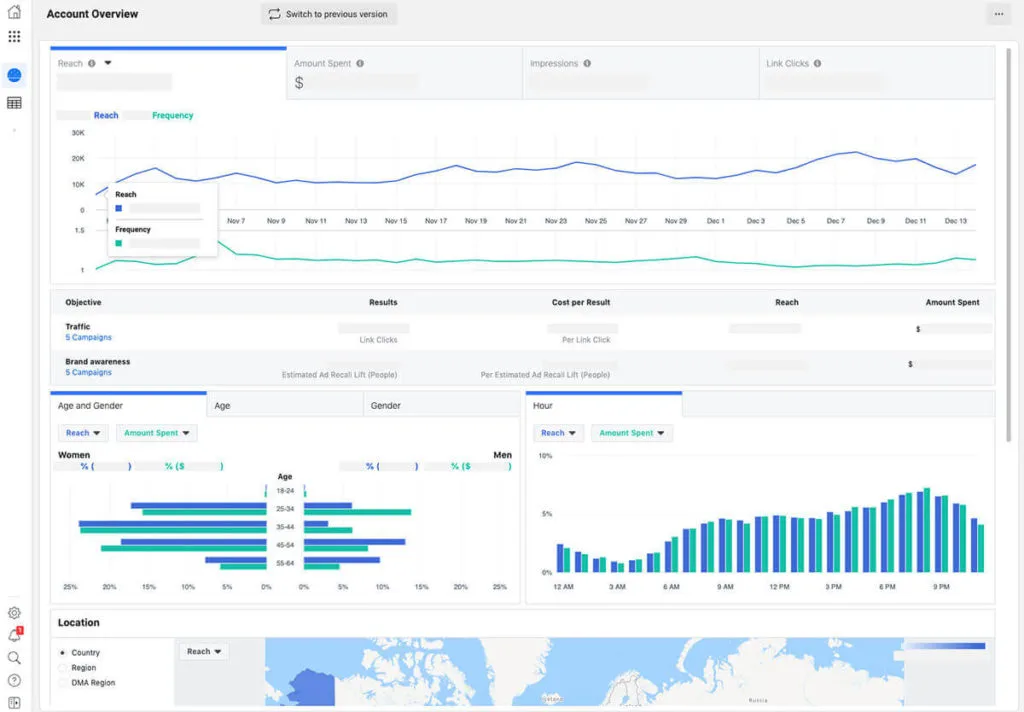How to Create a Social Media Strategy From Scratch
- Marketing Strategy
- Social Media Marketing

In the fall of 2019, we had a local children’s author, Hillary Daecher, reach out to us seeking help in developing a social media marketing strategy. Hillary had no prior experience of any kind with any social media platforms so we dug in to create a social media strategy from scratch.
This project was Hillary’s first step into the social media world. While I had more experience with social media in general, this was my first time creating a social media strategy. Throughout this process I had to determine what to include in the plan, who to target, which platforms to use, and how to organize it all into simple, actionable steps.
Getting Started With Social Media Strategy
Maybe you are in a similar situation. There are a million different ways you can set up a social media plan and it can seem overwhelming if you’re new to the game. But it’s not as difficult as it seems. As you follow the steps I’ve outlined, you will narrow your focus down to just the essentials. And, you’ll end up with a manageable plan centered around only the most important, relevant information.
Are you looking to create a social media strategy for someone else or for your business? Or maybe you’re a freelancer / one-man team. If you’re a beginner when it comes to creating social media strategies like I was, then this blog is for you. Trust me, you can do this, too! No prior experience necessary!
What is a Social Media Strategy?
A social media strategy is a marketing plan that is created to successfully utilize relevant social media platforms to reach your goals. Strategies and plans will vary greatly depending on a number of factors:
- Audience
- Product / service
- Industry
- Budget
- Competition
Think of social media strategy as a road map. The purpose of the plan is to help you reach your goals (the end-point). The process of creating the strategy is like routing the best path from where you are to where you want to be. It will vary greatly depending on your specific start and end points.
One audience/platform may be right for someone else but not for you. Creating a plan will determine what roads you should take. Just like traveling from point A to point B, it is a linear process. You can’t skip ahead when traveling (unless you’ve figured out teleportation, in which case please fill me in), just like you can’t engage an audience before you build one.
How Do you Create & Implement a Social Media Strategy
There is no one-size-fits-all social media marketing plan. Everyone has a different point A and B. Luckily, there is an abundance of platforms and tools to choose from, each with their own advantages and disadvantages. There are best practices that everyone can follow, but the intricacies of a plan will depend largely on the factors above. I will run through the process we completed for our client as an example of how to create a fully customized social media plan.
Why Create a Social Media Strategy?
Social media marketing has become a necessity to individuals and businesses looking to grow. Social media platforms enable people to connect with massive audiences they wouldn’t be able to otherwise. Social media platforms are tools for businesses, enabling them to reach their goals by targeting their audience by demographics, geography, interests, and more.
Why not create a social media strategy? Social media platforms are largely free! These massive platforms allow you to connect with your audience on a very personal level, in a way you traditionally can’t through other mediums such as: email, organic search, website traffic, or referrals. These mediums are tremendously important, but social media taps into a different type of connection with your audience to complement your overall marketing strategy.
There are a vast amount of platforms to choose from, so there is something for everyone. Seriously! Here are the top 75 social media platforms to know for 2020. There are also many goals that can be accomplished through the use of social media, including:
- Brand awareness
- Visibility
- Website traffic
- Lead generation
- Signups
- Sales
- Engagement
- Building a community
- Promotion of events
First Step: Define Goals
Goals can vary greatly depending on the business / individual. Take some time to write down and solidify your goals as a first step. Gather information, determine what your current position is, where you want to go, what you have to offer, and who you want to serve.
In this case our client desired to:
- Build brand recognition
- Increase visibility
- Build connections
- Engage her audience
- Promote visits & book readings
- Sell books
Who Will Your Social Media Plan Be Focused On?
Once you have your goals clearly defined, you will need to determine who you will be connecting with. Who is your customer? Who are your biggest fans? Who does your product / service serve? If you are unsure, you can start broad and narrow down as you go, adjusting your strategy to the metrics and KPIs (key performance indicators) discussed later in this post.
Second Step: Define Your Audience
Hillary’s soon-to-be published children’s book is about overcoming fears and obstacles. In this case, the audience was:
- Parents with young children (Pre-K to 2nd grade)
- Child counselors
- Child therapists
- Children’s book authors
- Independent authors
- Booksellers
- Librarians / libraries
- Child care facilitators / facilities
- Hummingbird groups / festivals
I determined this audience through an interview my co-workers conducted with Hillary. If you’re developing a plan for someone else, talk to them about who their audience is. Do research. If possible, get the decision-maker involved! Ask them questions. Ask who they serve, who is the product/service made for? Here is a list of questions to ask your client or yourself to define your audience!
Data Sources for Defining Your Audience
Other tools to gather data about your audience include Google Analytics and the Census (if you’re in the United States). Using these resources will help you gather demographic and geographic data, and learn about interests and behaviors. Here is a useful guide to using Google Analytics audience data. Don’t guess who your audience is, use the data available to you.
Once you have your target audience narrowed down, use your gathered information to create a persona. A persona is a fictional character you create to represent your target audience. Learn how to create a persona here. Next, you will determine where your audience is!
What Social Media Platforms to Use?
Third Step: Choose Your Platforms
There are a vast number of different social media platforms to choose from, so it’s important to determine which platforms are the most relevant to your business, and focus on them first. Ideally you only start with a few to avoid becoming overwhelmed, unless you hire a social media marketing team to manage the workload.
Some of the largest social media platforms include:
- Youtube
Do industry-specific research to find any other smaller, niche social media platforms relevant to your business. In Hillary’s case, Facebook, Instagram, and Goodreads were determined to be the most important platforms to begin with:
- Facebook has the largest user platform and is one of the most widely-used platforms in terms of demographics. This would be used for information-based content.
- Instagram was chosen to use as a visual / moment-based platform, focusing more on photos and videos regarding Hillary’s book and process.
- Goodreads was chosen to reach her niche audience. Goodreads is a great social media platform for authors to network with readers and book lovers.
Do some research on your industry and the different types of platforms out there to determine what social media platform to use. Hootsuite does a great job categorizing channels into 10 different types of social media platforms.
If you want to learn more about LinkedIn advertising, our guide to LinkedIn ads goes over everything you need to run a successful campaign.
When Should You Be Active on Social Media?
Social media marketing is an ongoing process that requires frequent posts and engagement. This can vary by industry but a general rule of thumb is to post at least once a day. Inactivity has been shown to decrease visibility, leading to less engagement, which leads to even less visibility.
While posts should be frequent, it is important that it’s not a bombardment of posts trying to sell people on things. People are not on social media to be sold to. People trust people, not businesses. As a business, you’ll want to be personable, interact with people, and focus on building relationships and community.
The number of posts should be frequent regardless of industry, but how frequent can be determined by some basic competitor research. The audience for certain industries is more / less active than other audiences. Take some time to look into the activity of the industry leaders and the community and match the activity levels.
Implementation
There are certain best practices we will recommend in implementing your plan, like useful tools that can schedule posts if you have windows of time to work on your strategy. Another option is hiring social media specialists to manage your accounts. The time of day matters for posts as well. Experiment and see what works best for your audience, but here is some data on the best times to post on social media.
Scheduling
There are scheduling features built into some platforms (e.g: Facebook) but others may not have these capabilities. You likely don’t have the time to constantly be working on the social media strategy, so scheduling can help you make the best use of the time you have available.
Set aside a few hours and create a social media calendar. Decide what useful, helpful, relevant content you’re going to create and share, and plan when it will be shared. Third-party tools like Hootsuite, SocialOomph, and SEMrush can help you automate deployment. Here is a list of some more of the top social media scheduling tools.
Combine your research on the industry, your competitors, your audience, and the best times to post. Then set up a strategic schedule using these resources!
How to Organize Your Social Media Plan
Fourth Step: Organize Your Plan
As you do your research to determine your goals, audience, and platforms, write everything down! Write out all your thoughts and potential plans. It’s okay to be messy at first. We can clean it up later! I recommend creating a mind map.

This is the first draft of the mind map I made for Hillary.
Start from the center, and branch out with the goals you determined. Match potential platforms with the goals they can serve, and then extend the audience you can serve from those platforms. This practice can help visualize how things will work together, and how the system operates as a whole.
Once you start to narrow things down, you can organize your data using the mind mapping tool, Mindmeister. Here you can see I broke down the plan into five goals, and six potential platforms with ideas of what purposes they can serve.

But six platforms is a lot to handle, especially for one person! So we took this information and narrowed it down even further. We selected the three most vital platforms for her to get off the ground. Once we had our goals, audience, and platforms defined, it was time to break down our goals into steps and phases.

Each goal is now numbered in succession. Think about the logical process that needs to occur in order for your goals to work. Each phase is an ongoing process and will take time to develop.
Phase One
Since our client was starting from scratch first we needed to increase her visibility and her brand. This became phase one. We can not create connections, engage, acquire visit opportunities, or sell books without having visibility. This phase included reaching out to groups, inviting contacts to like her pages, creating content, and building out her platforms.
Phase Two
Once we increase visibility and brand awareness, we will be able to create connections. This includes cultivating relationships in groups, posting in discussions, leaving reviews, participating in Q & As, and connecting with new people within Hillary’s circles. This must be done before focusing on engagement.
Phase Three
Once visibility has grown, and connections have been established, the next goal is to engage with your community! Just like any social act, you are looking to cultivate these relationships. Post relevant content that your community will be interested in. Share content, ask questions, and have conversations!
Phase Four
The fourth phase is based around finding and promoting book readings and visits down the road. Having built connections with her audience, she may be able to find new opportunities for events and increase attendance to scheduled events.
Phase Five
The fifth and final phase is based around selling her books. A lot of people make the mistake of trying to set up shop on social media solely to sell things. This misses the point completely. Social media is about community and connection with others, not, “look at me! Buy my stuff.”
Obviously, as a business, you will have a service / product you would like to sell, but the main purpose is to cultivate relationships. If you build successful relationships, you will be able to provide a product / service that aligns with your customers needs and wants, and they will happily support you.
Basic Principles for ANY Person on ANY Platform
- SOCIAL media is a SOCIAL act. Engage with your community!
- Post high-quality content.
- Post frequently.
- Engage with followers.
- Be authentic.
- Ask questions.
- Include visuals when possible.
- Know your audience and write to them.
How to Know If It’s Successful
Track it to hack it! Fortunately, most platforms provide a lot of data regarding the performance of your account. The specific metrics you will want to focus on will vary depending on your goals, but there are plenty of commonly tracked metrics across industries/goals.
Some metrics to track for organic (non-paid) efforts:
- Engagement
- Reach
- Impressions
- Referral traffic to your website
- Likes / followers
- Comments
- Ratings / reviews
For example, the Facebook Insights tab hosts the majority of these metrics all in one place! Keep an eye on the metrics listed above. Experiment. Make notes of what changes you make and see what affects these metrics for the better or worse.

Some metrics to track for ads / paid efforts:
- Click-through-rate (CTR)
- Cost-per-click (CPC)
- Cost-per-action (CPA)
- Conversions
- Ad frequency
Facebook provides all of this data and more. The most important thing to do is to use the data you have available to you. Watch for changes in these metrics and take advantage of these insights!

Social advertising is a beast in itself, but can be a very effective and cost-efficient way to increase your reach and leads.
Resources
Different platforms work best with different image sizes. Use this always-up-to-date guide to social media image sizes to ensure your content is optimized for the selected channel.
If you need content ideas, browse Google Trends or Exploding Topics.
Another way to utilize social media is by optimizing your website for social media.
Some of the software we use to run and create social media strategies includes Google Analytics, SEMrush, and Facebook Ads. Google Analytics is an incredibly powerful tool for determining who your audience is. Here is a guide on how to use Google Analytics to evaluate your audience.
So What’s Next?
Building out this social media strategy, I learned a lot of valuable information and found the whole process rewarding. Hillary followed the plan and has seen a lot of success come from it, and I couldn’t have been happier to hear that. Creating this strategy and this road map kept us accountable and on track, and served as an actionable guide to reach the goals we set.
I know this can be difficult and I know it’s a lot! But I promise you it’s worth the effort. Time to create your social media strategy. Please feel free to reach out to me on LinkedIn and ask for help or to share your story. I’d love to hear from you! Building and implementing a social media strategy can be time-consuming but it can also be very rewarding. Human beings are social creatures, we thrive on communicating with others and that is how social media has become such a huge part of our lives.
If you’re looking to build your brand, engage your audience, and reach potential customers, it’s time to embrace the tools available to you. Our specialists can help you get more out of your social media efforts.
 Alex S
Alex S